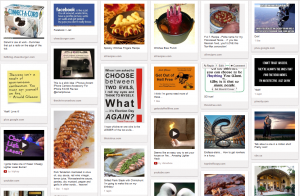Pinterest has enjoyed immense popularity and has catapulted rapidly to the third ranked social media site, traffic-wise. It is image based, taking advantage of the fact that most people are visually stimulated, particularly by images they consider humorous, unique or interesting. It certainly can generate traffic. Yet, there seems to be a broad disparity in how different types of users see Pinterest, in terms of usage.

From a blog owner’s perspective, Pinterest often offers a channel via which substantial site traffic can be generated. Since the majority of blogs aren’t monetized and most bloggers are primarily interested in branding (and erroneously view site traffic as a success metric), posting of cute, interesting and amusing images quickly gained popularity with this group. And for the most part, their efforts could be said to be pure of thought and deed, even if only of momentary benefit.
Of course, those that make their livings on the Internet know that “traffic” alone means nothing. If traffic doesn’t convert, it’s just more noise. Enter: the Pinterest Marketer.
Marketing on Pinterest
Inevitably, as with any other new engagement channel, there were those that saw a marketing opportunity and adopted early to capitalize on it. If done wisely, Pinterest can be an effective tool. But much like a screw can be driven into wood with a hammer, there is definitely a wrong way to do things there.
So… is the Pinterest platform a social media or a marketing channel? Evidence suggests that it can be both, when properly employed.
People respond best to things they can identify with. An image of an innovative space-saving design, an amazing, do-it-yourself, low-budget room facelift or a simple recipe for an elegant hors d’oeuvre can often capture attention, offer a desired result and enlist new followers. If you’re providing the reader with the necessary information to achieve the same result, or can offer them other similar value, you may gain a subscriber or even a sale.
But let’s take a look at some of the things we’ve learned that are important, after watching a similar evolution on Twitter and Facebook.
Some Dos & Don’ts for Pinterest
[list type=”check3″]
- Me-me-me – if the majority of your pins are promotional, it’s a given that you’re likely to alienate some portion – probably a sizable portion – of your following. Nobody likes being sold to constantly, regardless of how much your images might attract them. Be generous with your repins and sparing with your promotional pins.
- When it rains, it pours – inundating your followers with twenty or thirty new images every day may well chase people off, too. Spread your pinning out a bit – remember how annoying it is to see a dozen consecutive tweets from the same person in your Twitter stream? Pinterest is no different, in that regard. If you feel you have that many goodies to pin, use Reachli (previously known as Pinerly) to schedule them throughout the day.
- Be original – Don’t just repin things from other members’ boards. Sprinkle some new images in too. They don’t have to be images from your own site… remember, Pinterest is a social media site… even if you’re there for your business’ sake, you still need to keep people interested. In fact, especially if you’re pinning for your business.
- Know your audience – we should all know by now that it’s important to know who we’re talking to, whether you’re speaking as a business or an individual, and to adjust our presentation accordingly. When marketing, the audience demographic is even more important, and Pinterest is no different. The audience on Pinterest is predominantly female – match your audience.
- Don’t broadcast – don’t just use Pinterest as a way to broadcast your sales messages… that’s one of the quickest ways to turn people off and chase them away. Pin and repin images that are fun, useful and enjoyable.
- Be catchy – by selecting images that will attract interest and using witty or informative captions, your pins will be more likely to be re-pinned. Putting one of the best images as the cover photo on your folder is always a good idea, too. Remember, you’re trying to engage people.
- Be sociable – this doesn’t just mean re-pinning… you should also put a Follow Us On Pinterest banner on your site’s pages, as well as a Pin It button on each page (not on each image). This will encourage your readers to pin your images to their folders, extending your reach.
- Be imaginative – besides selecting great images and adding interesting captions, you can also generate interest with contests and giveaways. People love winning free items – even items they’ve never thought about before.
[/list]
Many of the above tips can apply equally to either personal or business use of Pinterest – indeed, any social media platform. For the most part, it’s a simple matter – don’t do to others that which would irritate you if they did it to you.
A friend, Steve Gerencser, who is somewhat of a Master Pinner that has enjoyed considerable marketing success on Pinterest, authored A Quick Guide to Pinterest Marketing, with plenty of great tips (several of which I “borrowed” and listed above). He closes his guide with these wise words:
“Remember, Pinterest is about community as much as it is about pretty pictures and marketing.”




